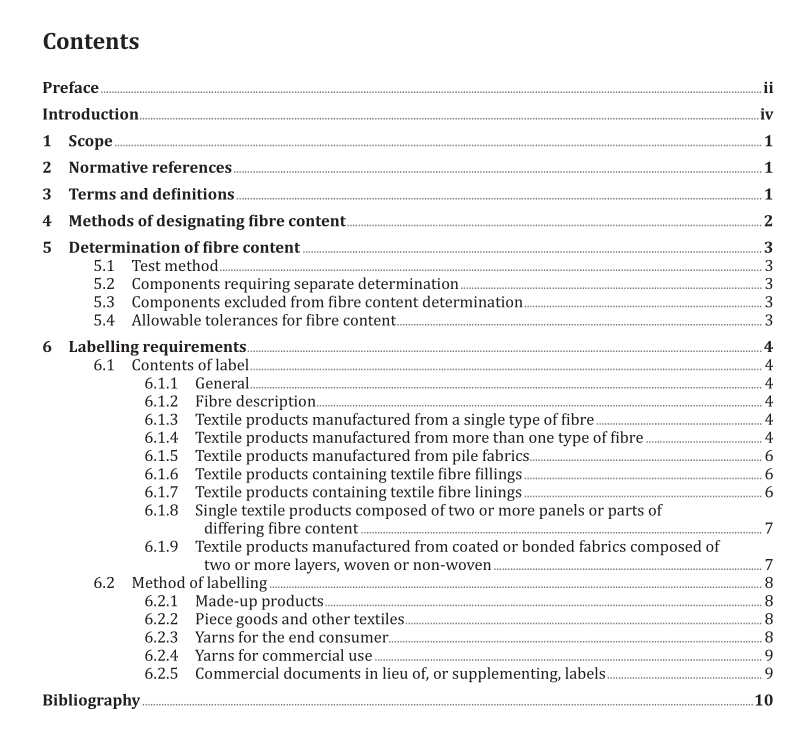AS 2622 pdf download – Textile products — Fibre content labelling

AS 2622 pdf download – Textile products — Fibre content labelling
1 Scope
This Standard sets out two methods for designating the fibre content of textile products and for supplying this information on made-up products, piece goods and yarns. It also specifies the methods to be used for determining the fibre content of a product. This Standard is applicable to all textile products. Refer to Australian and State Government legislation for those products exempted from fibre content labelling.
2 Normative references
The following documents are referred to in the text in such a way that some or all of their content constitutes requirements of this document.
NOTE Documents for informative purposes are listed in the Bibliography.
AS 2001.7, Methods of test for textiles, Method 7: Quantitative analysis of fibre mixtures
AS/NZS 2450, Textiles—Natural and man-made fibres—Generic names
ISO 1833 (all parts), Textiles
AATCC 20, Fiber analysis: Qualitative
AATCC 20A, Fiber analysis: Quantitative
ASTM D629, Standard Test Methods for Quantitative Analysis of Textiles
3 Terms and definitions
For the purposes of this document, the following terms and definitions apply.
3.1
attachment
fastenings such as buttons and zips
3.2
bonded fabric
product created by attaching more than one layer of fabric together
3.3
coated fabric
product created by applying a continuous layer of polymer to a fabric
3.4
made-up product
assembled garment or article, manufactured from any textile fibre
EXAMPLE Apparel, manchester, furnishings, carpets.
3.5
permanent label
tag or sticker able to withstand the method of cleaning specified for the article and able to remain legible and attached to the article throughout its useful life
3.6
reclaimed fibre
reprocessed product from used clothing, fibrous material, and scraps from textile and clothing manufacturing
Note 1 to entry: This does not include recycled fibre and cannot be used interchangeably.
3.7
shall
indicates that a statement is mandatory
3.8
should
indicates a recommendation
3.9
textile fibre
natural or man-made material characterized by its flexibility, fineness, high length to thickness ratio,and suitability for textile applications
EXAMPLEWool, hair, silk, cotton, flax and any other fibrous material.3.10
textile product
article manufactured or semi-manufactured from textile fibre by spinning, weaving, knitting, felting.bonding, tufting or other process
EXAMPLE Thread, cord, rope, braids, lace, embroidery, nets, carpet, clothing and fabrics.3.11
trim
ornament applied to a textileEXAMPLE
Tape, embroidery, ribbon, ruffles, overlay, applique,and gimp.
4Methods of designating fibre content
The two methods of designating fibre content are as follows:(a
Method A
Listing, in descending order of dominance by mass, the generic name of each fibre typepreceded by its percentage of the total mass of the textile product.
(b)
Method B
Listing, in descending order of dominance by mass, the generic name of each fibre type.
The generic names of natural and man-made fibres to be used are specified in AS/NZS 2450.If nogeneric name describes a fibre, the fibre shall be specified as man-made.No abbreviations or alternativenames shall be used.
Rayon, the generic name used in some countries for regenerated cellulose fibres, may be added to thegeneric names cupro, modal, polynosic and viscose, e.g. viscose rayon.
For many years the name linen has been widely used and accepted in fibre content labelling linen andflax blends in consumer goods. Therefore, although flax is the generic name,the name linen may be usedin lieu of flax in labelling consumer goods.
NOTE Other products made from natural materials should be labelled with their correct name and according tothe labelling requirements within this Standard (e.g. feather, fur etc. in trims).
5 Determination of fibre content
5.1 Test method The fibre content of a product shall be determined in accordance with the methods of AS 2001.7, as applicable. Where AS 2001.7 does not apply, fibre content shall be determined in accordance with an appropriate method from the ISO 1833 series, AATCC 20, AATCC 20A or ASTM D629. Results shall be based on clean, dry mass with allowances for moisture and other matter in accordance with AS 2001.7—2005 Section 2.
5.2 Components requiring separate determination Where a textile product includes textile fibre filling, lining or both, the fibre content of these components is determined separately for individual listing on the fibre content label, see Clauses 6.1.6 and 6.1.7.









